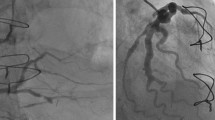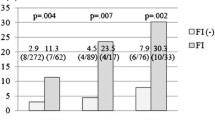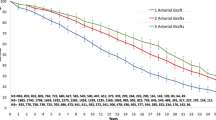Abstract
Background
The study assessed the graft flow to the coronary arteries during coronary artery bypass grafting in 175 patients receiving a composite single or double mammary grafts.
Methods
128 patients with single inlet and 47 with double inlet composite arterial grafts were evaluated. In on pump — prior to, and following release of aortic cross clamp-and in off pump settings, graft blood flow was measured using an ultrasonic Transit Time Volume flowmeter.
Results
On pump, unrestricted blood flow was lower in single inlet than in double inlet grafts (119.9 ± 6.9 ml/min versus 161.0 ± 14.0ml/min (P=0.0042). There was also significantly less blood flow through the single inlet system when the heart was beating (74.7 ± 3.7 ml/min versus 98.0 ± 8.1 ml/min (P=0.0018)). We also found that patients operated on pump had larger graft flow than patients operated off pump (85.6 ± 4.6 ml/min versus 69.5 ± 3.8ml/min (P = 0.042)). Gender and number of anastomoses to the coronary arteries, were not predictive for graft flow.
Conclusions
Double inlet arterial graft systems supply the heart with larger graft flow than single inlet arterial graft systems. This benefit was obtained at the price of a longer duration of the operation, corresponding to the time it takes to harvest the right ITA.
Similar content being viewed by others
References
Cooper GJ, Underwood MJ, Deverall PB. The lima success story-whither other arterial grafts—are vein grafts obsolete? Br J Clin Pract 1996; 50: 144–50.
Bonatti J, Nagele G, Hangler H, et al. Extraanatomical coronary artery bypass grafts on the beating heart for management of the severely atherosclerotic ascending aorta. Heart Surg Forum 2002; 5: 272–81.
Galbut DL, Traad EA, Dorman MJ, et al. Seventeen-year experience with bilateral internal mammary artery grafts. Ann Thorac Surg 1990; 49: 195–201.
Leacche M, Carrier M, Bouchard D, et al. Improving neurologic outcome in off-pump surgery: the “no touch” technique. Heart Surg Forum 2003; 6: 169–75.
Lev-Ran O, Ben-Gal Y, Matsa M, et al. ’No touch’ techniques for porcelain ascending aorta: comparison between cardiopulmonary bypass with femoral artery cannulation and off-pump myocardial revascularization. J Card Surg 2002; 17: 370–76.
Royse AG, Royse CF, Tatoulis J. Total arterial coronary revascularization and factors influencing in-hospital mortality. Eur J Cardiothorac Surg 1999; 16: 499–505.
Tatoulis J, Buxton BF, Fuller JA, Royse AG. Total arterial coronary revascularization: techniques and results in 3,220 patients. Ann Thorac Surg 1999; 68: 2093–2099.
Hangler HB, Nagele G, Danzmayr M, et al. Modification of surgical technique for ascending aortic atherosclerosis: impact on stroke reduction in coronary artery bypass grafting. J Thorac Cardiovasc Surg 2003; 126: 391–400.
Christensen JB, Lund JT, Kassis E, et al. Complete arterial coronary revascularisation using radial artery conduit for double thoracic artery inlet flow: arterial sling operation. Eur J Cardiothorac Surg 2002; 21: 391–394.
Hirose H, Amano A, Takahashi A. Triple arterial coronary revascularization using the radial artery and bilateral internal mammary arteries versus the gastroepiploic artery and bilateral internal mammary arteries. Circ J 2002; 66: 544–548.
Nikoloudakis N, Wendler O, El Dsoki S, Graeter T, Schafer HJ. Complete arterial revascularisation in patients older than 70 years. Thorac Cardiovasc Surg 2001; 49: 369–372.
Prifti E, Bonacchi M, Frati G, Leacche M, Bartolozzi F, Giunti G. Off-pump total arterial myocardial revascularization according to the right Y-graft configuration. J Card Surg 2003; 18: 8–16.
Ganong WK. Review of Medical Physiology. 9th Edition. Los Altos, California 94022, Lange Medical Publishers, ISBN 0-87041-135-37.
Wendler O, Hennen B, Markwirth T, et al. T grafts with the right internal thoracic artery to left internal thoracic artery versus the left internal thoracic artery and radial artery: flow dynamics in the internal thoracic artery main stem.” J Thorac Cardiovasc Surg 1999; 118: 841–848.
Tagusari O, Kobayashi J, Bando K, et al. Early adaptation of the left internal thoracic artery as a blood source of y-composite radial artery grafts in off-pump coronary artery bypass grafting. Heart Surg Forum 2003; 6: E93–E98.
Lemma M, Innorta A, Pettinari M, et al. Flow dynamics and wall shear stress in the left internal thoracic artery: composite arterial graft versus single graft. Eur J Cardiothorac Surg 2006; 29: 473–478.
Author information
Authors and Affiliations
Corresponding author
Rights and permissions
About this article
Cite this article
Irmukhamedov, A., Christensen, J.B., Fabrin, A.K. et al. Total arterial coronary revascularization - Single or double inlet system?. Indian J Thorac Cardiovasc Surg 24, 1–4 (2008). https://doi.org/10.1007/s12055-008-0001-9
Received:
Revised:
Accepted:
Published:
Issue Date:
DOI: https://doi.org/10.1007/s12055-008-0001-9




